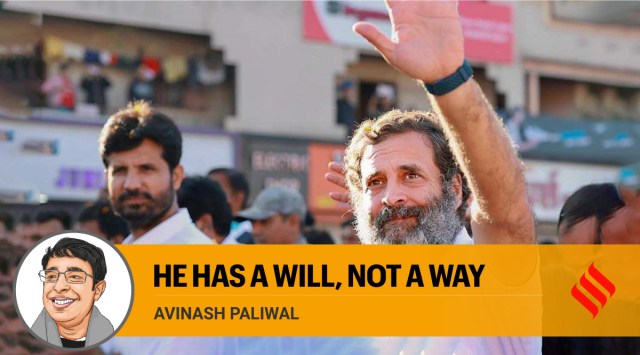
Democracy in India is a “global public good”, Rahul Gandhi added as an afterthought. It can’t fail. Speaking in the British Parliament to a hall packed with politicians, diaspora leaders, students and academics, he’d just outlined why India’s democratic structures are under threat. From the Hindu right’s institutional capture to its stifling of dissent, targeting of minorities to curtailing media freedoms, the list is long. His appeal was heartfelt, experiences from the Bharat Jodo Yatra spectacular, and focus on inequality, unemployment, institutional integrity and women’s rights apt. He’s not a political greenhorn — quite the opposite. But despite such merits, Gandhi failed to convince.
Not because he was raising questions about India’s democratic credentials on foreign soil. That charge cuts both ways. Not because he’s travelling abroad (again) when he should’ve been at his party office, consoling workers after losses in Nagaland, Meghalaya and Tripura. The charge of excessive international travel also cuts both ways.
Even the criticism that he can miss the mark when responding to basic questions is harsh if somewhat accurate. He at least takes questions. Finally, the charge that he represents dynastic politics, though legitimate, is not new. The Gandhis are not alone in that space.
To grasp why Gandhi is not the haloed pro-democracy fighter, there’s a need to focus on the albatross that hangs around his neck.
He has a will but not a way. It is this antinomy that made the ruling Bharatiya Janata Party (BJP) confident enough to not interrupt his walk across the length of India. He views the Yatra as a huge political act and the largest mobilisation that the country has seen in decades. There’s no doubt that the Yatra did Congress good. But to confuse it as mass mobilisation that could reinvent national political mood is the kind of error that rookies, or self-obsessed politicians, make. Gandhi is not a rookie.
That’s the first problem. The Yatra was about improving Gandhi’s image. He claims that “ten years ago I wouldn’t have imagined that I will need to walk 4,000-km to spread the word”. He also notes that he walked because he wanted to listen to people, and that there’s an under-current against the BJP. But when someone asked what the people of India actually told him, he didn’t answer the question. Instead, he admitted that he wasn’t really clear about the purpose of the walk till he hit the road. To be honest, I see where he’s coming from.
But then acknowledge that the Yatra was just an exercise in self-discovery and improving image? These are important aims in which he succeeded. To obfuscate it as mass mobilisation without once mentioning the 2020-21 farmers’ protests, the 2019-2020 Shaheen Bagh protests, or the 2022 Bharat Bandh, all of which hold the mettle needed to reshape India’s body politic, raises questions about Gandhi’s intent. After all, it’s difficult to miss the contrast between the coercive state response and media silences faced by these protestors, and the ease with which Gandhi’s Yatra proceeded. Is this all about him, or is he serious about Opposition politics?
Gandhi’s failure to build alliances, both within and outside the Congress, makes this question pressing. In the party, he’s losing old allies faster than winning new ones. The list of defections is large and unceasing. Triggered by the Congress’s shrinking financial war-chest, and Gandhi’s dogged pursuit for inner-party control, such losses cannot be more ill-timed. Indira Gandhi could pull off such centralisation because she inherited a party in power. Rahul has inherited loss. But his actions don’t betray that. Even with other Opposition parties, some of whom have successfully challenged the BJP in their states, there’s little humility on display.
No wonder Gandhi wants to return to an India he grew up in, where one could “converse” (many couldn’t), instead of offering a promising alternative future to India’s aspirational youth. This became painfully evident when he responded to questions about governance. Asked what are the first things he’ll do if he comes to power, Gandhi said that he’ll “think about” how to strengthen India’s democratic space. The answer clarified that he doesn’t have a fix to the “global public good” he seeks to protect, even if he has identified areas of legitimate concern.
Similarly, on India’s status as a power, he claimed to not like the term “leading” and wants India to be a “bridging” power. As India’s response to the Russia-Ukraine war shows, it already is a bridging power. That’s a worthy goal to have in practice, and not as easy to achieve as one would think. But Gandhi’s statement is ironic for different reasons. For a politician who’s refusing to give up his leadership position and failing to build bridges even on his side of the parliamentary floor, how does he plan to make India a global bridging power?
Plus, if voting patterns show one thing it is this: Indians want to see the country become a leading power. It might not happen today, or anytime soon for that matter. But that’s a shared aspiration across India’s class, caste, ethnic, linguistic, racial, and gender divides. Even British parliamentarians and policymakers, regardless of whether or not they find Hindu nationalism agreeable, see India as a future leading power. And yet here is Gandhi echoing a term from the past, betraying an odd disconnect with what the people of India might want to hear from him.
The writer teaches at SOAS University of London and is the author of My Enemy’s Enemy: India in Afghanistan from the Soviet Invasion to the US Withdrawal (New York: Oxford University Press, 2017)